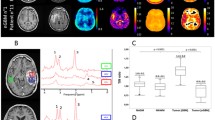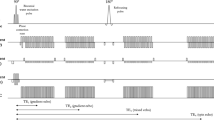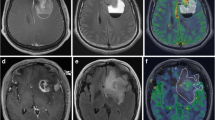Abstract
Hypoxia plays a central role in tumor stem cell genesis and is related to a more malignant tumor phenotype, therapy resistance (e.g. in anti-angiogenic therapies) and radio-insensitivity. Reliable hypoxia imaging would provide crucial metabolic information in the diagnostic work-up of brain tumors. In this study, we applied a novel BOLD-based MRI method for the measurement of relative oxygen extraction fraction (rOEF) in glioma patients and investigated potential benefits and drawbacks. Forty-five glioma patients were examined preoperatively in a pilot study on a 3T MR scanner. rOEF was calculated from quantitative transverse relaxation rates (T2, T2*) and cerebral blood volume (CBV) using a quantitative BOLD approach. rOEF maps were assessed visually and by means of a volume of interest (VOI) analysis. In six cases, MRI-targeted biopsy samples were analyzed using HIF-1α-immunohistochemistry. rOEF maps could be obtained with a diagnostic quality. Focal spots with high rOEF values were observed in the majority of high-grade tumors but in none of the low-grade tumors. VOI analysis revealed potentially hypoxic tumor regions with high rOEF in contrast-enhancing tumor regions as well as in the non-enhancing infiltration zone. Systematic bias was found as a result of non-BOLD susceptibility effects (T2*) and contrast agent leakage affecting CBV. Histological samples demonstrated reasonable correspondence between MRI characteristics and HIF-1α-staining. The presented method of rOEF imaging is a promising tool for the metabolic characterization of human glioma. For the interpretation of rOEF maps, confounding factors must be considered, with a special focus on CBV measurements in the presence of contrast agent leakage. Further validation involving a bigger cohort and extended immuno-histochemical correlation is required.



Similar content being viewed by others

References
Rong Y, Durden DL, Van Meir EG, Brat DJ (2006) ‘Pseudopalisading’ necrosis in glioblastoma: a familiar morphologic feature that links vascular pathology, hypoxia, and angiogenesis. J Neuropathol Exp Neurol 65:529–539
Bar EE, Lin A, Mahairaki V, Matsui W, Eberhart CG (2010) Hypoxia increases the expression of stem-cell markers and promotes clonogenicity in glioblastoma neurospheres. Am J Pathol 177:1491–1502. doi:10.2353/ajpath.2010.091021
Eckerich C, Zapf S, Fillbrandt R, Loges S, Westphal M, Lamszus K (2007) Hypoxia can induce c-Met expression in glioma cells and enhance SF/HGF-induced cell migration. Int J Cancer 121:276–283. doi:10.1002/ijc.22679
Jensen RL (2009) Brain tumor hypoxia: tumorigenesis, angiogenesis, imaging, pseudoprogression, and as a therapeutic target. J Neuro Oncol 92:317–335. doi:10.1007/s11060-009-9827-2
Schwartz DL, Bankson J, Bidaut L, He Y, Williams R, Lemos R, Thitai AK, Oh J, Volgin A, Soghomonyan S, Yeh HH, Nishii R, Mukhopadhay U, Alauddin M, Mushkudiani I, Kuno N, Krishnan S, Bornman W, Lai SY, Powis G, Hazle J, Gelovani J (2011) HIF-1-dependent stromal adaptation to ischemia mediates in vivo tumor radiation resistance. Mol Cancer Res 9:259–270. doi:10.1158/1541-7786.MCR-10-0469
Harrison LB, Chadha M, Hill RJ, Hu K, Shasha D (2002) Impact of tumor hypoxia and anemia on radiation therapy outcomes. Oncologist 7:492–508
Sathornsumetee S, Cao Y, Marcello JE, Herndon JE, McLendon RE, Desjardins A, Friedman HS, Dewhirst MW, Vredenburgh JJ, Rich JN (2008) Tumor angiogenic and hypoxic profiles predict radiographic response and survival in malignant astrocytoma patients treated with bevacizumab and irinotecan. J Clin Oncol 26:271–278. doi:10.1200/JCO.2007.13.3652
Bergers G, Hanahan D (2008) Modes of resistance to anti-angiogenic therapy. Nat Rev Cancer 8:592–603. doi:10.1038/nrc2442
Aronen HJ, Gazit IE, Louis DN, Buchbinder BR, Pardo FS, Weisskoff RM, Harsh GR, Cosgrove GR, Halpern EF, Hochberg FH (1994) Cerebral blood volume maps of gliomas: comparison with tumor grade and histologic findings. Radiology 191:41–51
Lupo JM, Cha S, Chang SM, Nelson SJ (2007) Analysis of metabolic indices in regions of abnormal perfusion in patients with high-grade glioma. AJNR Am J Neuroradiol 28:1455–1461. doi:10.3174/ajnr.A0586
Pacheco-Torres J, López-Larrubia P, Ballesteros P, Cerdán S (2011) Imaging tumor hypoxia by magnetic resonance methods. NMR Biomed 24:1–16. doi:10.1002/nbm.1558
Krohn KA, Link JM, Mason RP (2008) Molecular imaging of hypoxia. J Nucl Med 49(2):129S–148S. doi:10.2967/jnumed.107.045914
McMillan KM, Rogers BP, Field AS, Laird AR, Fine JP, Meyerand ME (2006) Physiologic characterisation of glioblastoma multiforme using MRI-based hypoxia mapping, chemical shift imaging, perfusion and diffusion maps. J Clin Neurosci 13:811–817. doi:10.1016/j.jocn.2005.12.025
Siemonsen S, Fitting T, Thomalla G, Horn P, Finsterbusch J, Summers P, Saager C, Kucinski T, Fiehler J (2008) T2′ imaging predicts infarct growth beyond the acute diffusion-weighted imaging lesion in acute stroke. Radiology 248:979–986. doi:10.1148/radiol.2483071602
Saitta L, Heese O, Förster AF, Matschke J, Siemonsen S, Castellan L, Westphal M, Fiehler J, Goebell E (2011) Signal intensity in T2′ magnetic resonance imaging is related to brain glioma grade. Eur Radiol 21:1068–1076. doi:10.1007/s00330-010-2004-3
Hattingen E, Jurcoane A, Bähr O, Rieger J, Magerkurth J, Anti S, Steinbach JP, Pilatus U (2011) Bevacizumab impairs oxidative energy metabolism and shows antitumoral effects in recurrent glioblastomas: a 31P/1H MRSI and quantitative magnetic resonance imaging study. Neuro Oncol. doi:10.1093/neuonc/nor132
Yablonskiy DA, Haacke EM (1994) Theory of NMR signal behavior in magnetically inhomogeneous tissues: the static dephasing regime. Magn Reson Med 32:749–763
Yablonskiy DA (1998) Quantitation of intrinsic magnetic susceptibility-related effects in a tissue matrix. Phantom study. Magn Reson Med 39:417–428
An H, Lin W (2003) Impact of intravascular signal on quantitative measures of cerebral oxygen extraction and blood volume under normo- and hyper-capnic conditions using an asymmetric spin echo approach. Magn Reson Med 50:708–716. doi:10.1002/mrm.10576
He X, Yablonskiy DA (2007) Quantitative BOLD: mapping of human cerebral deoxygenated blood volume and oxygen extraction fraction: default state. Magn Reson Med 57:115–126. doi:10.1002/mrm.21108
Kennan RP, Zhong J, Gore JC (1994) Intravascular susceptibility contrast mechanisms in tissues. Magn Reson Med 31:9–21
Weisskoff RM, Kiihne S (1992) MRI susceptometry: image-based measurement of absolute susceptibility of MR contrast agents and human blood. Magn Reson Med 24:375–383
Yablonskiy DA, Sukstanskii AL, He X (2012) Blood oxygenation level-dependent (BOLD)-based techniques for the quantification of brain hemodynamic and metabolic properties—theoretical models and experimental approaches. NMR Biomed. doi:10.1002/nbm.2839
Spees WM, Yablonskiy DA, Oswood MC, Ackerman JJ (2001) Water proton MR properties of human blood at 1.5 Tesla: magnetic susceptibility, T(1), T(2), T*(2), and non-Lorentzian signal behavior. Magn Reson Med 45:533–542
Silvennoinen MJ, Clingman CS, Golay X, Kauppinen RA, van Zijl PC (2003) Comparison of the dependence of blood R2 and R2* on oxygen saturation at 1.5 and 4.7 Tesla. Magn Reson Med 49:47–60. doi:10.1002/mrm.10355
Baudrexel S, Volz S, Preibisch C, Klein JC, Steinmetz H, Hilker R, Deichmann R (2009) Rapid single-scan T2*-mapping using exponential excitation pulses and image-based correction for linear background gradients. Magn Reson Med 62:263–268. doi:10.1002/mrm.21971
Hirsch NM, Preibisch C (2012) T2* mapping with background gradient correction using different excitation pulse shapes. AJNR Am J Neuroradiol. doi:10.3174/ajnr.A3021
Magerkurth J, Volz S, Wagner M, Jurcoane A, Anti S, Seiler A, Hattingen E, Deichmann R (2011) Quantitative T*2-mapping based on multi-slice multiple gradient echo flash imaging: retrospective correction for subject motion effects. Magn Reson Med 66:989–997. doi:10.1002/mrm.22878
Østergaard L (2004) Cerebral perfusion imaging by bolus tracking. Top Magn Reson Imaging 15:3–9
Helenius J, Perkiö J, Soinne L, Østergaard L, Carano RA, Salonen O, Savolainen S, Kaste M, Aronen HJ, Tatlisumak T (2003) Cerebral hemodynamics in a healthy population measured by dynamic susceptibility contrast MR imaging. Acta Radiol 44:538–546
Lu H, Law M, Johnson G, Ge Y, van Zijl PC, Helpern JA (2005) Novel approach to the measurement of absolute cerebral blood volume using vascular-space-occupancy magnetic resonance imaging. Magn Reson Med 54:1403–1411
Gempt J, Buchmann N, Ryang YM, Krieg S, Kreutzer J, Meyer B, Ringel F (2012) Frameless image-guided stereotaxy with real-time visual feedback for brain biopsy. Acta Neurochir (Wien) 154:1663–1667. doi:10.1007/s00701-012-1425-y
Remmele W, Hildebrand U, Hienz HA, Klein PJ, Vierbuchen M, Behnken LJ, Heicke B, Scheidt E (1986) Comparative histological, histochemical, immunohistochemical and biochemical studies on oestrogen receptors, lectin receptors, and Barr bodies in human breast cancer. Virchows Arch A Pathol Anat Histopathol 409:127–147
Raichle ME, MacLeod AM, Snyder AZ, Powers WJ, Gusnard DA, Shulman GL (2001) A default mode of brain function. Proc Natl Acad Sci USA 98:676–682. doi:10.1073/pnas.98.2.676
Christen T, Schmiedeskamp H, Straka M, Bammer R, Zaharchuk G (2011) Measuring brain oxygenation in humans using a multiparametric quantitative blood oxygenation level dependent MRI approach. Magn Reson Med. doi:10.1002/mrm.23283
Kumar R, Delshad S, Woo MA, Macey PM, Harper RM (2011) Age-related regional brain T2-relaxation changes in healthy adults. J Magn Reson Imaging. doi:10.1002/jmri.22831
Larsson HB, Courivaud F, Rostrup E, Hansen AE (2009) Measurement of brain perfusion, blood volume, and blood-brain barrier permeability, using dynamic contrast-enhanced T(1)-weighted MRI at 3 tesla. Magn Reson Med 62:1270–1281
Zhang Y, Wang J, Wang X, Zhang J, Fang J, Jiang X (2012) Feasibility study of exploring a T@-weighted dynamic contrast-enhanced MR approach for brain perfusion imaging. J Magn Reson Imaging 35:1322–1331. doi:10.1002/jmri.23570
Sourbron S, Ingrisch M, Siefert A, Reiser M, Herrmann K (2009) Quantification of cerebral blood flow, cerebral blood volume, and blood-brain-barrier leakage with DCE-MRI. Magn Reson Med 62:205–217
An H, Lin W (2000) Quantitative measurements of cerebral blood oxygen saturation using magnetic resonance imaging. J Cereb Blood Flow Metab 20:1225–1236
Lange I, Hirsch N, Shao J, Preibisch C Effect of white matter fiber orientation and fractional anisotropy on T2* in human brain. In: ESMRMB 2012, p 88
Li TQ, van Gelderen P, Merkle H, Talagala L, Koretsky AP, Duyn J (2006) Extensive heterogeneity in white matter intensity in high-resolution T2*-weighted MRI of the human brain at 7.0 T. Neuroimage 32:1032–1040. doi:10.1016/j.neuroimage.2006.05.053
Bender B, Klose U (2010) The in vivo influence of white matter fiber orientation towards B(0) on T2* in the human brain. NMR Biomed 23:1071–1076. doi:10.1002/nbm.1534
Denk C, Hernandez Torres E, MacKay A, Rauscher A (2011) The influence of white matter fibre orientation on MR signal phase and decay. NMR Biomed 24:246–252. doi:10.1002/nbm.1581
Duyn JH, van Gelderen P, Li TQ, de Zwart JA, Koretsky AP, Fukunaga M (2007) High-field MRI of brain cortical substructure based on signal phase. Proc Natl Acad Sci USA 104:11796–11801. doi:10.1073/pnas.0610821104
Zhong K, Leupold J, von Elverfeldt D, Speck O (2008) The molecular basis for gray and white matter contrast in phase imaging. Neuroimage 40:1561–1566. doi:10.1016/j.neuroimage.2008.01.061
Chappell KE, Robson MD, Stonebridge-Foster A, Glover A, Allsop JM, Williams AD, Herlihy AH, Moss J, Gishen P, Bydder GM (2004) Magic angle effects in MR Neurography. AJNR Am J Neuroradiol 25:431–440
Buxton RB (2009) Introduction to functional magnetic resonance imaging: principles and techniques. Cambridge University Press, Cambridge
Landis CS, Li X, Telang FW, Coderre JA, Micca PL, Rooney WD, Latour LL, Vetek G, Palyka I, Springer CS Jr (2000) Determination of the MRI contrast agent concentration time course in vivo following bolus injection: effect of equilibrium transcytolemmal water exchange. Magn Reson Med 44:563–574. doi:10.1002/1522-2594(200010)
Kjølby BF, Østergaard L, Kiselev VG (2006) Theoretical model of intravascular paramagnetic tracers effect on tissue relaxation. Magn Reson Med 56:187–197. doi:10.1002/mrm.20920
Quarles CC, Gochberg DF, Gore JC, Yankeelov TE (2009) A theoretical framework to model DSC-MRI data acquired in the presence of contrast agent extravasation. Phys Med Biol 54:5749–5766. doi:10.1088/0031-9155/54/19/006
Tate MC, Aghi MK (2009) Biology of angiogenesis and invasion in glioma. Neurotherapeutics 6:447–457. doi:10.1016/j.nurt.2009.04.001
Tofts PS (1997) Modeling tracer kinetics in dynamic Gd-DTPA MR imaging. J Magn Reson Imaging 7:91–101
Patlak CS, Blasberg RG (1985) Graphical evaluation of blood-to-brain transfer constants from multiple-time uptake data. Generalizations. J Cereb Blood Flow Metab 5:584–590. doi:10.1038/jcbfm.1985.87
Heddleston JM, Li Z, McLendon RE, Hjelmeland AB, Rich JN (2009) The hypoxic microenvironment maintains glioblastoma stem cells and promotes reprogramming towards a cancer stem cell phenotype. Cell Cycle 8:3274–3284
Acknowledgments
We thank Ralf Deichmann for providing the template of source code for the correction of background gradients and motion in T2* mapping. This work was supported by the Deutsche Forschungsgemeinschaft (SFB 824: “Imaging for the selection, monitoring and individualization of cancer therapies,” Project B6). The data have been presented in parts at the annual meetings of the DGNR, Köln, Germany, October 2011 and at the annual meeting of the ASNR, New York, USA, April 2012.
Conflict of interest
The authors report no conflict of interest concerning the materials or methods used in this study or the findings described in this paper. No benefits in any form have been or will be received from any commercial party related directly or indirectly to the subject of this manuscript.
Author information
Authors and Affiliations
Corresponding author
Additional information
Vivien Tóth and Christine Preibisch contributed equally to the present work.
Rights and permissions
About this article
Cite this article
Tóth, V., Förschler, A., Hirsch, N.M. et al. MR-based hypoxia measures in human glioma. J Neurooncol 115, 197–207 (2013). https://doi.org/10.1007/s11060-013-1210-7
Received:
Accepted:
Published:
Issue Date:
DOI: https://doi.org/10.1007/s11060-013-1210-7



